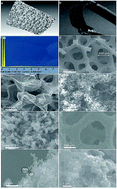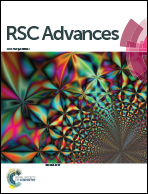Three dimensional (3D) flexible graphene foam/polypyrrole composite: towards highly efficient supercapacitors†
Abstract
Polypyrrole (PPY) functionalized 3 dimensional (3D) graphene foam (GF) with remarkable electrochemical performance has been synthesized in this work. The resulting 3D PPY–GF electrode is free standing and hence was used directly as a working electrode without using any binder or carbon additives. The unique features of the PPY–GF composites such as their hierarchically flexible 3D network, and high conductivity of p-doped PPY, afforded PPY–GF electrodes with enhanced pseudocapacitive properties. Under optimal conditions, a maximum specific capacitance of 660 F g−1, specific energy of 71 W h kg−1, comparable to battery performance, and a specific power of 2.4 kW kg−1 (at 0.5 mA) were obtained. Both GF and PPY–GF electrodes exhibited an excellent cycle life and retained almost 100% of their initial capacitances after 10 000 and 6000 charge–discharge cycles, respectively. This highly enhanced stability is attributed to the significant impact of the GF density on the flexibility of the electrode, and the hierarchical pore structures which provided short effective pathways for ion and charge transport and stayed unchanged after thousands of cycles. The PPY–GF pore size varies from a few nm for small pores to a hundred μm for macropores.


 Please wait while we load your content...
Please wait while we load your content...